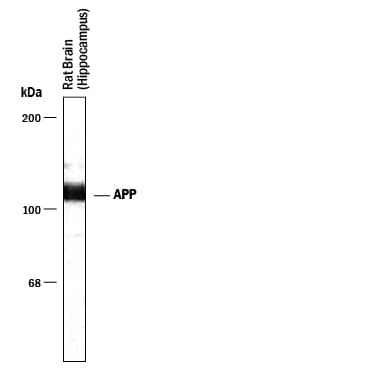APP Antibody
R&D Systems, part of Bio-Techne | Catalog # PPS044

Key Product Details
Species Reactivity
Human, Mouse, Rat, Canine, Chicken, Primate
Applications
Western Blot
Label
Unconjugated
Antibody Source
Polyclonal Rabbit IgG
Product Specifications
Immunogen
APP
Specificity
This antibody is specific for the ~120 kDa APP in Western blots of rat brain.
Clonality
Polyclonal
Host
Rabbit
Isotype
IgG
Scientific Data Images for APP Antibody
Detection of Amyloid Precursor Protein by Western Blot.
Western blot of rat hippocampal lysate showing specific immunolabeling of the approximately 120 kDa APP protein.Applications for APP Antibody
Application
Recommended Usage
Western Blot
1:1000 dilution
Sample: Rat brain (hippocampus) lysate
Sample: Rat brain (hippocampus) lysate
Formulation, Preparation, and Storage
Purification
Antigen Affinity-purified
Formulation
100 μL in 10 mM HEPES (pH 7.5), 150 mM NaCl, 100 μg/mL BSA and 50% glycerol.
Shipping
The product is shipped with polar packs. Upon receipt, store it immediately at the temperature recommended below.
Stability & Storage
For long-term storage, ≤ ‑20° C is recommended. Product is stable at ≤ ‑20° C for at least 1 year.
Background: APP
References
- Suzuki, T. et al. (2006) J. Biochem. 139:949.
- Chen, Y. and B.L. Tang (2006) Biochem. Biophys. Res. Commun. 341:1.
- Reinhard, C. et al. (2005) EMBO J. 24:3996.
- Mendendez-Gonzales, M. et al. (2005) Neurodegenerative Dis. 2:227.
- Nakagawa, K. et al. (2006) J. Neurochem. 96:924.
- Kang, J. et al. (1987) Nature 325:733.
Long Name
Amyloid Precursor Protein
Alternate Names
Amyloid beta, beta Amyloid, Protease Nexin II
Gene Symbol
APP
Additional APP Products
Product Documents for APP Antibody
Product Specific Notices for APP Antibody
For research use only
